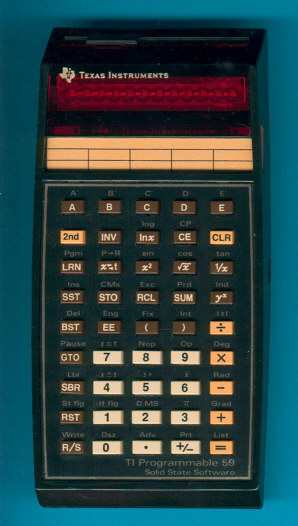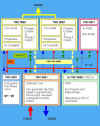
DATAMATH CALCULATOR MUSEUM
 |
DATAMATH CALCULATOR MUSEUM |
Texas Instruments TI-59
| Date of introduction: | May 24, 1977 | Display technology: | LED-stick |
| New price: | $299.95 (SRP 1977), £249.95 $180.00 (October 1981) |
Display size: | 10 (8 + 2) |
| Size: | 6.4" x 3.2" x
1.5" 162 x 81 x 37 mm3 |
||
| Weight: | 8.5 ounces, 240 grams | Serial No: | 2422430 |
| Batteries: | BP1A | Date of manufacture: | wk 29 year 1980 |
| AC-Adapter: | AC9131 or DC9105 | Origin of manufacture: | Netherlands |
| Precision: | 13 | Integrated circuits: | TMC0501E,
TMC0582, TMC0583,
TMC0571, TMC0594,
4*TMC0598 TMC0541 |
| Logic: | AOS - 8 Pending Operations, 9 () | ||
| Memories: | 0-100 | ||
| Program steps: | 960-160 | Courtesy of: | Joerg Woerner |
| Download leaflet: |
|
Download manual: |
|

![]()
 Introduced
together with the TI-58 these calculators introduced a
novelty, the Solid State Software Modules™ with up to 5000 program steps. On
the backside of the TI-58/59 you'll notice a small lid with a place for a module.
The Master Library with 25 different programs was included, a lot of other
modules were available.
Introduced
together with the TI-58 these calculators introduced a
novelty, the Solid State Software Modules™ with up to 5000 program steps. On
the backside of the TI-58/59 you'll notice a small lid with a place for a module.
The Master Library with 25 different programs was included, a lot of other
modules were available.
Don't miss the even greater program collection for the TI-59 resulting from the Professional Program Exchange (PPX-59) initiative started in November 1977.
It took just a few month before Reynolds
and Reynolds, headquartered in
 Compared with the SR-52 the memory
space was raised by a factor of four, sporting up to 100 memories or 960 program
steps. A new flexible approach allowed the conversion of one data memory
location to eight program
steps, base configuration was 60 memories and 480 program steps. Read more about
your first steps of programming this calculator here.
Compared with the SR-52 the memory
space was raised by a factor of four, sporting up to 100 memories or 960 program
steps. A new flexible approach allowed the conversion of one data memory
location to eight program
steps, base configuration was 60 memories and 480 program steps. Read more about
your first steps of programming this calculator here.
A similar calculator was sold with the huge desktop-model SR-60A.
Don't miss the odd TI-5230.
The TI-59 Programmable calculator marked the end of a calculator evolution started with the SR-50 three years ago. The SR-50 introduced in January 1974 was the first product based on the TMS0500 Building Blocks for Scientific and Programmable Calculators using just the TMC0501 Arithmetic Chip and one TMC0520 SCOM (Scanning and Read Only Memory) Chip for 1k*13 Bits Instruction Memory. The TI-59 Programmable calculator makes full use of the TMS0500 Building Blocks and a closer look at the PCB (printed circuit board) of the TI-59 reveals a total of nine PMOS (P-channel Metal–oxide Semiconductor) chips:
|
•
TMC0501E: Enhanced Arithmetic Chip – Register Processor with five 16-digit Registers and segment decoder/driver • TMC0582, TMC0583: TMC0580 Double Scanning and Read Only Memory Chip – 2.5k*13 Bits Instruction Memory with serial interface to Arithmetic Chip, 32 Constants with 16 digits, eight 16-digit Registers and 16-digit display scanning, each • TMC0571: TMC0560 Bare Read Only Memory Chips – 1k*13 Bits Instruction Memory with serial interface to Arithmetic Chip for a combined 6k*13 Bits Instruction Memory • TMC0594: Magnetic I/O Chip – Four channel interface for magnetic card reader to save and load programs with up to 480 steps • TMC0598*4: Four Multi-Register Chips – 240*8 Bits Random Access Memory with 4-bit I/O Bus to Arithmetic Chip, stores 240 program steps or 30 numbers of 16 digits, each |

 Fellow
collector Sipke de Wal († May 13, 2004) created a block
diagram of the TI-59 calculator and a very detailed diagram of the TMC0501
centered architecture.
Fellow
collector Sipke de Wal († May 13, 2004) created a block
diagram of the TI-59 calculator and a very detailed diagram of the TMC0501
centered architecture.
If you are interested in the calculating accuracy of scientific calculators
don't miss the Calculator
forensics.
 Comparing
the Constant ROM Content with
the programmed constants frequently used with computing algorithm of
trigonometric functions like sine, cosine, or tangent of an SR-50 manufactured in
May 1974 still using the original TMC0521-2 SCOM Chip with the TMC0582
DSCOM Chip
of the featured TI-59 with our
TMS0500 Platform after recording their
ROM Images showed no
differences.
Comparing
the Constant ROM Content with
the programmed constants frequently used with computing algorithm of
trigonometric functions like sine, cosine, or tangent of an SR-50 manufactured in
May 1974 still using the original TMC0521-2 SCOM Chip with the TMC0582
DSCOM Chip
of the featured TI-59 with our
TMS0500 Platform after recording their
ROM Images showed no
differences.
![]()
![]() Looking into the Key Codes programmed into the second half of the
TMC0581 and the complete TMC0582 and comparing with the Source Code from Texas
Instruments' US Patent Application #4,153,937 ("A microprocessor system with higher order capabilities provided with two non-volatile memories which are read-only memories in the disclosed embodiment... for use as an electronic calculator")
showed no differences. We didn't fully compare the
Instruction ROM Content
distributed over the two TMC0580 SCOM and one TMC0560 BROM Chips of the
featured TI-59 manufactured in May 1979 with the above mentioned US Patent but a
few samples revealed no differences.
Looking into the Key Codes programmed into the second half of the
TMC0581 and the complete TMC0582 and comparing with the Source Code from Texas
Instruments' US Patent Application #4,153,937 ("A microprocessor system with higher order capabilities provided with two non-volatile memories which are read-only memories in the disclosed embodiment... for use as an electronic calculator")
showed no differences. We didn't fully compare the
Instruction ROM Content
distributed over the two TMC0580 SCOM and one TMC0560 BROM Chips of the
featured TI-59 manufactured in May 1979 with the above mentioned US Patent but a
few samples revealed no differences.
The TI-59 uses a card reader for magnetic strips,
unfortunately they were neither compatible to the SR-52 nor was the drive reliable.
Fellow calculator collector Marek Czeszek
prepared wonderful Step-by Step Instructions how
to clean a TI-59 and repair the card reader. Interested in other calculators
with a magnetic card reader? Don't miss the Casio
PRO fx-1.
Both TI-58 and TI-59 sport the connector to the printing cradle, these calculators work on the PC-100A, PC-100B and PC-100C revision.
American Micro Products introduced with the Module Selector a very interesting product fitting into the charging bay of the printing cradles.
The calculator was available till the year 1983.
Don't miss the TI-1750 introduced only few weeks before the TI-59, the first LCD-calculator sold by Texas Instruments.
The TI-59 was mentioned in TI's press release dated August 15, 2002 to celebrate the 35th anniversary of its invention of the electronic calculator.
Andreas Gerlich scanned recently the German documentation of the TI-59, please visit his website. Thanks!
• Emulating a TI-58/59
If you don't own a TI-58/59 calculator - emulate it!
| TI Programmable 59
Magnetic card programmable calculator with plug in Solid State Software* and magnetic card storage for business, science, engineering. Up to 960 program steps, or up to 100 memories. When integrated with any of the libraries it delivers up to 5000 program steps. © Texas Instruments, 1981 |
If you have additions to the above article please email: joerg@datamath.org.
© Joerg Woerner, December 5, 2001. No reprints without written permission.